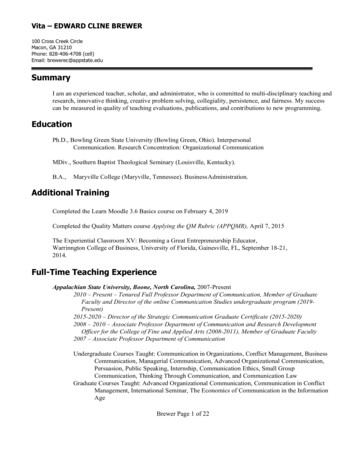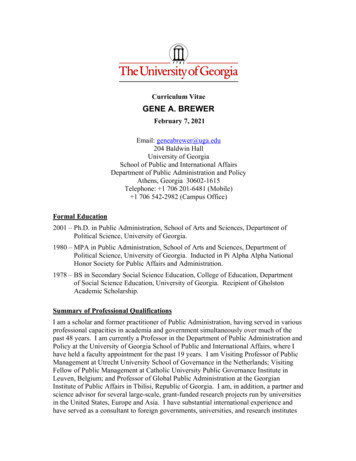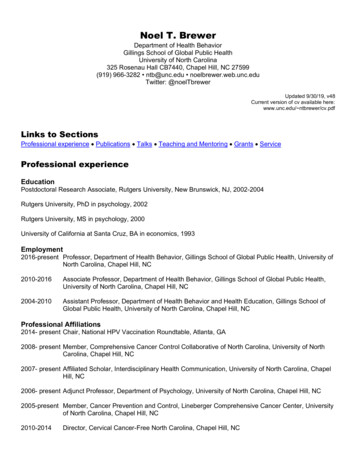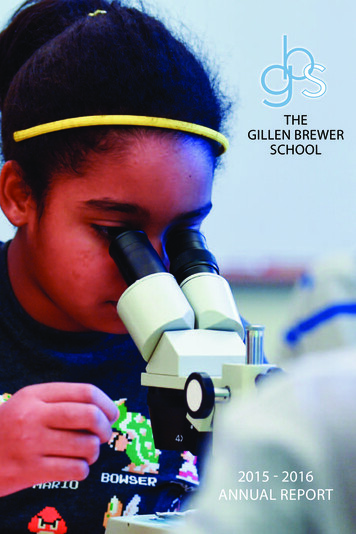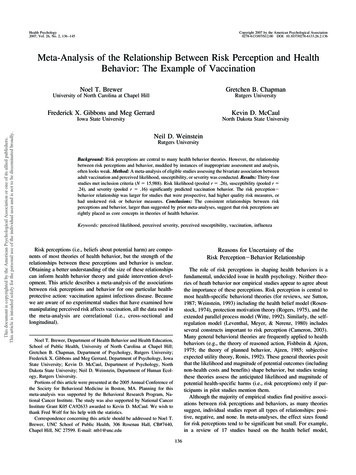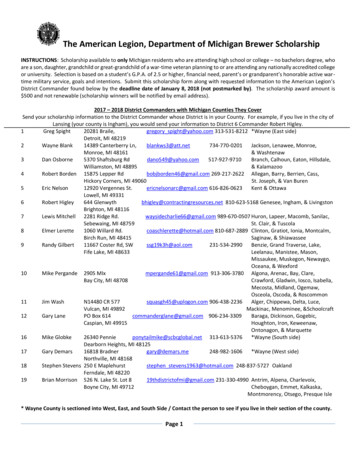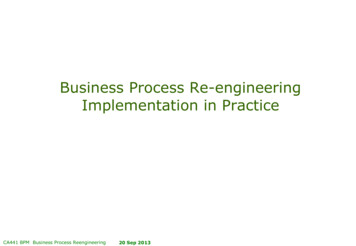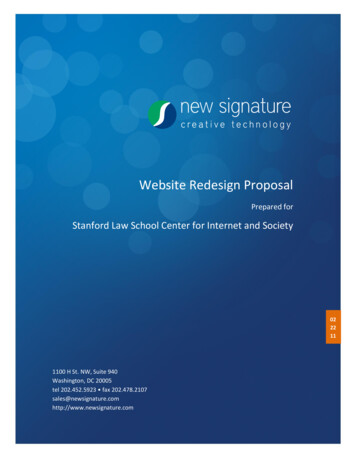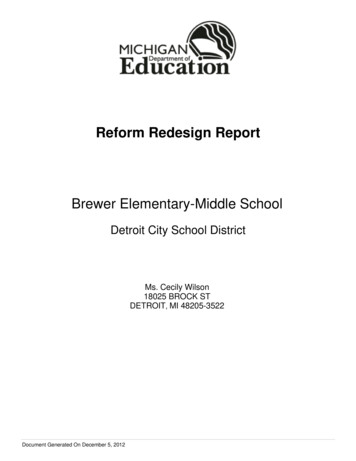
Transcription
Reform Redesign ReportBrewer Elementary-Middle SchoolDetroit City School DistrictMs. Cecily Wilson18025 BROCK STDETROIT, MI 48205-3522Document Generated On December 5, 2012
TABLE OF CONTENTSIntroduction1Executive SummaryIntroduction3Description of the School4School's Purpose5Notable Achievements and Areas of Improvement6Additional Information7Transformation Redesign DiagnosticIntroduction9PART A: REFORM TEAM PERSONNEL10PART B: TEACHING AND LEARNING PRIORITIES11PART C: DEVELOP/INCREASE SCHOOL LEADERSHIP AND TEACHER EFFECTIVENESS13PART D: COMPREHENSIVE INSTRUCTIONAL REFORM STRATEGIES20PART E: INCREASED LEARNING TIME AND COMMUNITY ENGAGEMENT22PART F: PROVIDING OPERATIONAL FLEXIBILITY AND SUSTAINED SUPPORT25Assurances ReportMichigan Department of Education AssurancesPriority Assurances2929
Reform Redesign ReportBrewer Elementary-Middle SchoolIntroductionAs a school identified by the Michigan Department of Education as a Priority school, you are required to select one of the fourfederal models for your reform/redesign plan. If your school is selecting the closure or restart models, you should contact theSchool Reform Office to discuss the next steps for implementing and documenting this effort. If selecting either theTransformation or Turnaround model, you should review and respond to all individual requirements of the selected model.These plans are reviewed and need to be approved by the School Reform Officer.SY 2012-2013 2012 AdvancEDPage 1www.advanc-ed.org
Reform Redesign ReportBrewer Elementary-Middle SchoolExecutive SummarySY 2012-2013 2012 AdvancEDPage 2www.advanc-ed.org
Reform Redesign ReportBrewer Elementary-Middle SchoolIntroductionEvery school has its own story to tell. The context in which teaching and learning takes place influences the processes and procedures bywhich the school makes decisions around curriculum, instruction, and assessment. The context also impacts the way a school stays faithfulto its vision. Many factors contribute to the overall narrative such as an identification of stakeholders, a description of stakeholderengagement, the trends and issues affecting the school, and the kinds of programs and services that a school implements to support studentlearning.The purpose of the Executive Summary (ES) is to provide a school with an opportunity to describe in narrative form the strengths andchallenges it encounters. By doing so, the public and members of the school community will have a more complete picture of how the schoolperceives itself and the process of self-reflection for continuous improvement. This summary is structured for the school to reflect on how itprovides teaching and learning on a day to day basis.SY 2012-2013 2012 AdvancEDPage 3www.advanc-ed.org
Reform Redesign ReportBrewer Elementary-Middle SchoolDescription of the SchoolDescribe the school's size, community/communities, location, and changes it has experienced in the last three years. Includedemographic information about the students, staff, and community at large. What unique features and challenges are associatedwith the community/communities the school serves?Brewer Academy is striving to become an institution where students learn in a safe and healthy environment. We are striving to become atechnological institution where students are actively engaged in learning while meeting the requirements for adequate yearly progress.Brewer Academy had an enrollment of 607 students enrolled in grades Kindergarten through eight. One hundred percent of the studentpopulation is African-American. Brewer Academy has only been a K-8 configuration for three years. The students who live within theboundaries of Brewer Academy have been devastated by economic hardships; therefore, we have seen an increase in at-risk students. In aneffort to address the needs of at-risk students, the school has a Resource Coordinating Team (RCT) that meets on a monthly basis toaddress the needs of students by identifying and devise an action plan to meet the educational needs of the students. A Title I counselorcoordinates the meetings between the parents and the RCT. In addition, parents are invited to LSCO meetings, parent-teacher conferences,and various school activities to remain well-informed about their child's academic performance. Initial communications are sent home on thefirst day of school year and on a monthly basis throughout the school year. Brewer operates under a School-wide Title I program.Brewer is located on the eastside of Detroit, which has been hit hard economic times. Many homes have been demolished in the area andmany once vibrant blocks have now become vacant fields. However, due to the changes of the community our student population hasremained consistent and has exceeded the Districts' projection since 2009. Due to the housing market failure, many families have mergedtogether so their children may continue to attend Brewer.Regardless, of the declining neighborhood, parents are eager to partner with the school and learn helpful tips to help their children becomesuccessful. Many of our parents participate in the "Work First" program through the State of Michigan, but never miss an opportunity tocollaborate with the school during LSCO Meetings, parent-teachers, parent meetings and School Improvement Team.SY 2012-2013 2012 AdvancEDPage 4www.advanc-ed.org
Reform Redesign ReportBrewer Elementary-Middle SchoolSchool's PurposeProvide the school's purpose statement and ancillary content such as mission, vision, values, and/or beliefs. Describe how theschool embodies its purpose through its program offerings and expectations for students.Vision StatementBrewer Academy is striving to become an institution where students learn in a safe and healthy environment. We are striving to become atechnological institution where students are actively engaged in learning while meeting the requirements for adequate yearly progress.Mission StatementBrewer Academy will embrace the challenge of educating all children within a global society, by developing and implementing a structuredand effective learning environment. This learning environment will provide an opportunity for all students to effectively meet their academicneeds, through a dynamic learning experience. The staff of Brewer Academy will instill a sense of mutual respect in our students throughexemplary staff role models, and peer mediation.Belief StatementThe staff at Brewer Academy believes that all students can learn and will achieve academic excellence when given the opportunities andresources that will enhance learning. In addition the Title I Staff will establish programs that will ultimately have a positively impact on theacademic success of Brewer Students. Strategies and programs will effectively and decrease the achievement gap of Brewer Students.SY 2012-2013 2012 AdvancEDPage 5www.advanc-ed.org
Reform Redesign ReportBrewer Elementary-Middle SchoolNotable Achievements and Areas of ImprovementDescribe the school's notable achievements and areas of improvement in the last three years. Additionally, describe areas forimprovement that the school is striving to achieve in the next three years.Brewer Academy has received notable achievements through its Academic Games program. The school has won State Academic GamesChampionship academic games in the following years, 2009 through 2011, earning National championship status last year. Also, Brewerwas the only urban school to attend the National Science Bowl in Washington, DC, in 2009 through 2011. Brewer also holds the title ofRegional Science Bowl Champions for 2009 and 2010 and the students had the opportunity to meet our first lady, Michelle Obama. BrewerAcademy has demonstrated success in the areas of parental involvement, school climate, and safety. We are currently striving in increaseacademic achievement through the use of data to guide instruction and to identify and implement intervention strategies, as denoted throughwalk through by the leadership team. Brewer is continuing to create a culture of high expectations through providing challenging learningexperiences and rigor.SY 2012-2013 2012 AdvancEDPage 6www.advanc-ed.org
Reform Redesign ReportBrewer Elementary-Middle SchoolAdditional InformationProvide any additional information you would like to share with the public and community that were not prompted in the previoussections.Brewer has a deeply dedicated staff that functions as a family and supports student achievement and the ideology that all students can learnand become successful citizens in society.SY 2012-2013 2012 AdvancEDPage 7www.advanc-ed.org
Reform Redesign ReportBrewer Elementary-Middle SchoolTransformation Redesign DiagnosticSY 2012-2013 2012 AdvancEDPage 8www.advanc-ed.org
Reform Redesign ReportBrewer Elementary-Middle SchoolIntroductionThe Transformation Model addresses four specific areas: 1) developing teacher and school leader effectiveness, which includes replacingthe principal who led the school prior to commencement of the transformational model; 2) implementing comprehensive instructional reformstrategies; 3) extending learning and teacher planning time and creating community-oriented schools; and 4) providing operating flexibilityand sustained support.SY 2012-2013 2012 AdvancEDPage 9www.advanc-ed.org
Reform Redesign ReportBrewer Elementary-Middle SchoolPART A: REFORM TEAM PERSONNELPlease list the individuals involved in the development of this reform/redesign plan. Use a separate line to list each individual, andinclude name, title or role, and email contact information.Cecily WilsonPrincipalCarol MooreAcademic Engagement Officercarol.moore02@detroitk12.orgRoslyn RuffinTitle One Teacherroslyn.ruffin@detroitk12.orgJustin KemenyTeacherAddie Delahoussaye TeacherLaronda glaronda.paden@detroitk12.orgDeVette Brown-Tucker Teacherdevette.brown-tucker@detroitk12.orgVanessa Canady Teachervanessa.canady@detroitk12.orgBrenda Phillips School Improvement Facilitatorbrjoph@aol.comNancy Fentonnancyfenton@comcast.netIntervention SpecialistSY 2012-2013 2012 AdvancEDPage 10www.advanc-ed.org
Reform Redesign ReportBrewer Elementary-Middle SchoolPART B: TEACHING AND LEARNING PRIORITIESState 2-3 big ideas for your reform/redesign plan that are intended to change teaching and learning in your school. At least one ofthese should be instructional in nature. (These should come from the data dialogue that initiates your planning efforts.)Brewer Academy will implement two strategic reform ideas in order to change teaching and learning at our school. First, we will create andcultivate a climate of high expectation for increased learning for all students by all stakeholders at Brewer School. Secondly, we will usetiered intervention driven by data dialogue to guide instruction and positively impact student achievement in core content areas.Research by;" Abott, Joireman, Stroh, 2002, cites the following; Changing School Culture to Improve Climate' shows that with fewexceptions, a positive school climate impacts schools in the following way: Less prone to violence, substance abuse and higher graduationrates. Research was gathered from more than 75,000 students in 127 schools and it confirmed that positive building and classroom climatesimpacted student achievement. "McNeely, Nonnemaker & Blum, Promoting School Connectness: Evidence from the National LongitudinalStudy of Adolescent Health, Journal of School Health, April 2002, Vol 72, No4 Pg 138- 146.The rationale for the selection of Big Idea I: Cultivating a climate of high expectations for increased student learning was based upon dataand reflective dialogues, which was the focus of our opening school improvement and follow-up staff meetings. This transformation effort isalso supported by the data from our SIP/ School Profile/ Perception Data 2010 - 2011. Data results were gleamed from surveys issued toteachers, students and parents. Perception data ratings to classify perception(s) of the school climate (from all stakeholders) werecategorized by the following ranges: " None, Few, Some, Most, All", (Refer to data results in section below). Results from our data reflecteda need to address school climate in our transformation model in order to support student achievement.Our second big idea reform strategy which will impact instruction, indicates the use of tiered intervention driven by data dialogue todifferentiate instruction and postively impact all student achivement in core content areas. Data dialogue is a collective process designed tocreate a shared understanding of issues and events using information from many difference resources. It separates inquiry, analysis andproblem finding from the rush to decide and the rush to act" (Wellman, Lipton 40)The rationale for the selection of the Big Idea II (Instructional) was based upon an analysis of data (See section II for data results) and datadriven dialogues. In order to address the transformation efforts that will be put in place, the staff will be actively engaged in on-going data dialogue to support them with developing a cohesive yet practical structure to focus instruction in order to personalize and differentiateinstruction to promote measurable student gains in core content areas. Evidence of success of the implementation of Big Idea II: Using datadriven dialogues to drive tiered intervention will be documented by improved student achievement with on-going formative and summativeassessments:DIBELS, STAR,MAP,MEAP,etc. Results from assessments will be analyzed and ongoing by weekly grade level meetings.Each grade level teacher will alternate leadership roles to serve as lead facilitator in the data driven dialogues. Dialogues will be focused onpre-test, interim and post test results, along with identified best practice support strategies to promote student achievement.State what data were used to identify these ideas.Brewer uses the following data; Perception (School Improvement Plan, MEAP. DIBELS, Star Reading, Star Math, MAP, as well as ongoingformative and summative assessments of current curriculum.Data analysis from our School Improvement Data Profile documented the following: (Teachers) There was (Some) movement toward apositive trend of the school working toward cultivating an environment for increased student learning by all Brewer stakeholders, howeverthere was a need for (Some) improvement. Surveys by teachers also reflected there was (Some) positive increase in perception as it relatedSY 2012-2013Page 11 2012 AdvancEDwww.advanc-ed.org
Reform Redesign ReportBrewer Elementary-Middle Schoolto school climate, which they felt positively impacted student performance in the classroom. (Most) primary students' surveys indicated thatthe Brewer School was a safe and a good place to learn. (Most) Middle school students felt that although the climate was improving,additional classes outside of the core curriculum needed to be put in place. They felt an offering of additional classes would support a morepositive school climate and cut down on the number of disruptions and/or behahior issues during the school day. Data from parent surveys(gathered from Annual Title I Parent Meeting, Oct. 2012) indicated that (Most) of the community/parents felt the climate of the school wasimproving under the leadership of the assigned principal over the past two years. However, perception data from surveys also indicated thefollowing: (Most) Parents felt the climate for learning would improve greatly if there were more opportunities for extended learningopportunities both inside and outside of the standard offerings of the curriculum.(Field trips, gym, art technology, etc. Teacher surveys(Most) indicated a need to continue to build upon a climate that was conducive to learning by consistently maintaining and reinforcing currentpolicies and procedures (governance) which impact student learning. Data analyzed from teachers' perspective (All) felt strongly that aschool climate could only be conducive to learning, if there was a consistent structure and policies in the workplace. (All) felt these policiesand procedures must be understood and respected by all parties (leadership, students, parents, if the school climate is to be conducive tolearning.What data was used to identify these ideas?, According to the School Data Profile and MEAP Trend Data:Trend Data from MEAP 2009 - 2012 indicates the following:Reading 2009-2010:highest level of proficiency for all grades was 29.9% (in grade 3)Reading 2010- 2011:highest Proficiency level for Reading for all grades was 28.4% (in grade3)Reading 2011 -2012, highest proficiency level for all grades in reading was 33% (in grade 7)Math 2009 -2010highest level of proficiency for all grades was 39.2% (in grade 5)Math2010 - 2011 highest level of proficiency for all grades was 45.7% (in grade 6)Math2011 - 2012 highest level of proficiency for all grades was 26% (in grade 6)Science, Social Studies and Writing scores were also in the lowest percentile across the board as it relates to proficiency for all students whotook the exam in the designated gradesData from DIBELS indicates that only 27% of the students in grades K-5 are performing at a proficient level.The STAR Reading assessmentsindicates that 80% of students are performing below the 25th percentile, and STAR Math indicates that 77% of students are performingbelow the 25th percentile.Process for improving school climate is as follows:On-going data dialogue will give Brewer stakeholders a "Real Time "snapshot of what is working and what needs to be revised or revisitedfor groups as well as individual students. As we strive to promote student achievement, and improve school climate, we will be activelyengaged in the process of interpretative data dialogue. This will support us in making sound decisions which are reflective of "Best Practices.In order to implement the reform strategies it is important to look at the perception and academic data. Our MEAP Trend Data from 2009 topresent indicates a need to improve in all core content, for all students, in all core content areas as we work toward having a proficiency rateof 85% for all students by 2022.Evidence of success as it relates to improved school climate will be: fewer student referrals to office, less suspensions, and lessparent/teacher conference regarding disruptive behavior.SY 2012-2013 2012 AdvancEDPage 12www.advanc-ed.org
Reform Redesign ReportBrewer Elementary-Middle SchoolPART C: DEVELOP/INCREASE SCHOOL LEADERSHIP AND TEACHER EFFECTIVENESSDescribe how the building principal was replaced or how the existing principal meets the 2 year rule. Please include the leader'sname and discuss how the leader meets the criteria for a turnaround principal.The district will align the principal selection process for Priority Schools to the "two-year rule".Ms.Cecily Wilson is currently the principal at Brewer. She was assigned to a leadership role as the principal in 2009. Under her tenure, shereplaced at least 50% of the staff in August of 2012. This was a part of her initiative to staff Brewer with highly qualified teachers to providean exemplary education to our students.Cecily Wilson has raised the expecttions for all teachers and students of Brewer School and has demonstrated that she meets the criteria forbeing a turnaround leader in various capacities. She has and will continue to attend numerous professional development opportunities togain insight on differnent levels of leadership and Best Practices to utilize to move Brewer out of the "high priorty" status.She is a team builder, which is essential if the transformation initiative is to be successful. Action plans are also developed and supported bythe principal, in conjunction with the collaborative efforts of the school improvement team. She further demonstrates her ability to be atu
first day of school year and on a monthly basis throughout the school year. Brewer operates under a School-wide Title I program. Brewer is located on the eastside of Detroit, which has been hit hard economic times. Many homes have been demolished in the area an


